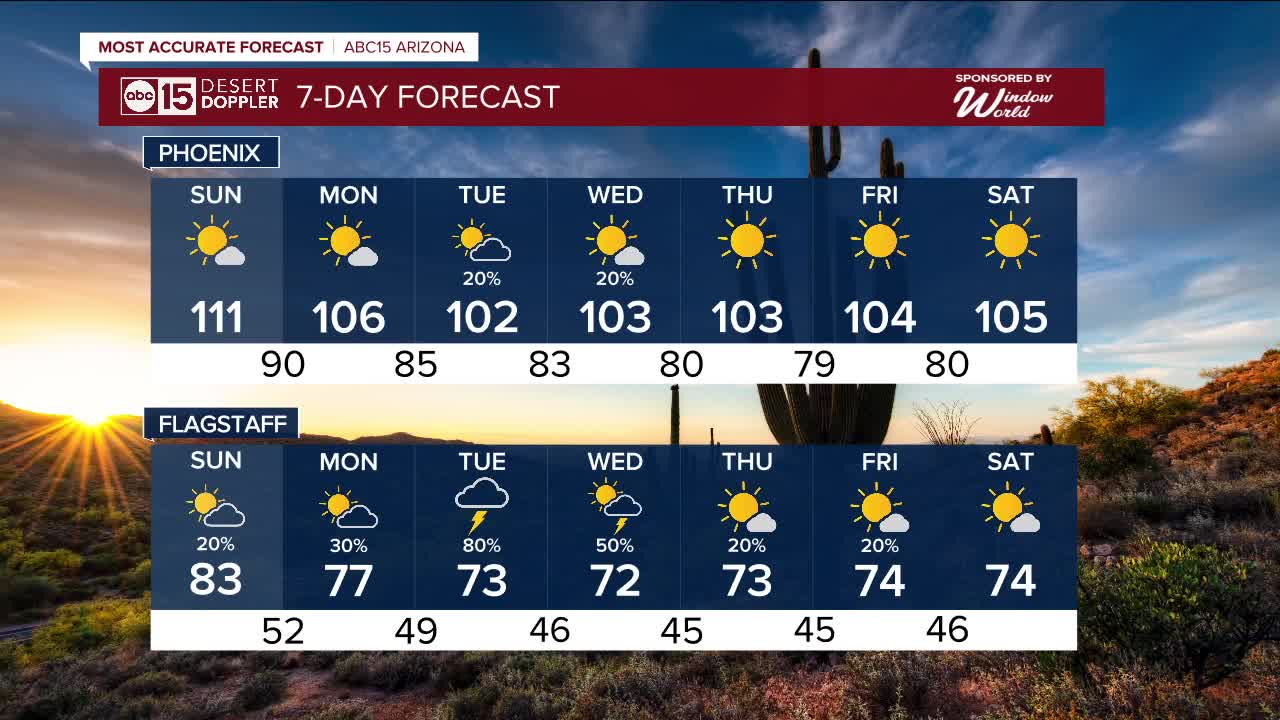The Reasons Behind Missing Excessive Heat Warnings In Forecasts

Table of Contents
Limitations in Current Meteorological Models and Data
Accurate temperature forecasting and, subsequently, effective excessive heat warnings, rely heavily on the capabilities of meteorological models. However, several limitations hinder their precision, especially when predicting extreme heat events.
Resolution and Accuracy Issues
Current weather prediction models often struggle to capture the highly localized nature of extreme heat. This is particularly true for urban areas, where the urban heat island effect significantly raises temperatures compared to surrounding rural regions. Coarse-resolution models simply can't resolve these fine-grained temperature variations.
- Insufficient data density in certain regions: Many developing countries lack the necessary network of weather stations to provide the high-resolution data needed for accurate modeling. This sparse data coverage directly impacts the model's ability to accurately predict localized extreme heat.
- Complex interactions: Accurately simulating the complex interactions between land surface temperature, atmospheric conditions, and the urban environment is incredibly challenging for even the most advanced models. Factors like building materials, vegetation cover, and human activity all play a role and are difficult to fully integrate into models.
Detailed Explanation: The resolution of a meteorological model refers to the size of the grid cells used in the simulation. Lower resolution means larger grid cells, leading to a loss of detail and an inability to capture localized temperature variations. High-resolution data, obtained from a dense network of weather stations, satellites, and other sources, is crucial for accurate heatwave forecasting, especially in capturing the impact of urban heat islands and other localized phenomena.
Challenges in Predicting Extreme Heat Events
Extreme heat events represent the tail end of the temperature probability distribution. This makes them inherently difficult to predict with high certainty because even small changes in initial conditions can lead to significant differences in model outputs.
- Sensitivity to initial conditions: Slight variations in initial atmospheric conditions (temperature, humidity, wind speed) can drastically alter a model's prediction, resulting in significant uncertainty in heatwave forecasting. This is a manifestation of the chaotic nature of weather systems.
- Unforeseen weather patterns: Sudden shifts in wind direction, unexpected cloud cover, or the development of unexpected weather systems can significantly impact temperatures and undermine the accuracy of heatwave predictions.
Detailed Explanation: The concept of chaotic systems in meteorology highlights the inherent unpredictability of weather beyond a certain time horizon. Small changes in initial conditions are amplified over time, resulting in large uncertainties in long-range forecasts, especially for extreme events like heatwaves.
Data Gaps and Accessibility
The accuracy of excessive heat warnings is profoundly impacted by the availability and quality of meteorological data. Significant data gaps and accessibility issues severely limit our ability to predict extreme heat events effectively.
Sparse Meteorological Stations and Data Quality
Many regions, especially in developing nations and remote areas, lack a sufficient density of meteorological stations to accurately capture localized temperature variations. This lack of ground-truth data limits the accuracy of both observation-based and model-based predictions.
- Data quality issues: Faulty sensors, inconsistent recording practices, and human error can significantly degrade the quality of meteorological data, introducing inaccuracies into both observations and model simulations.
- Limited access to real-time data: Restrictions in accessing real-time data from satellites, weather balloons, and other sources can further hamper forecast accuracy.
Detailed Explanation: A robust network of meteorological stations is crucial for accurate temperature monitoring and model calibration. Data quality control procedures are essential to ensure the reliability of observations and their effective use in forecasting. Data sharing and open access initiatives are vital to improve global forecasting capabilities.
Underreporting of Heat-Related Illnesses
Effective heat health warnings require an understanding of the actual impact of heat on the population. Unfortunately, underreporting of heat-related illnesses significantly hinders this understanding and, therefore, accurate risk assessment.
- Lack of standardized reporting: Inconsistent reporting systems across different healthcare providers and regions create difficulties in compiling a comprehensive picture of heat-related health impacts.
- Attribution challenges: It can be difficult to definitively attribute specific illnesses to extreme heat, further complicating data collection and analysis.
Detailed Explanation: Comprehensive public health surveillance systems are crucial for tracking heat-related illnesses and injuries. This data is vital for validating model predictions and improving the accuracy of heat health warnings, ensuring that vulnerable populations receive timely alerts and protection.
The Role of Climate Change and its Impact on Forecasting
Climate change is significantly altering the frequency, intensity, and duration of heatwaves, pushing the limits of current forecasting models and making accurate excessive heat warnings even more challenging.
Increasing Frequency and Intensity of Heatwaves
Climate change is not only making heatwaves more frequent and intense but also lengthening their duration. This makes it increasingly difficult for current forecasting models to accurately predict the timing, intensity, and extent of these events.
- Altered atmospheric circulation: Climate change is disrupting atmospheric circulation patterns, leading to more persistent and widespread heat events that are harder to predict using conventional methods.
- Compound extreme weather: The increasing occurrence of compound extreme events – for instance, heatwaves coinciding with droughts or wildfires – adds another layer of complexity to forecasting and increases the risk of severe impacts.
Detailed Explanation: The increase in greenhouse gases traps more heat in the atmosphere, leading to higher average temperatures and more frequent and intense heatwaves. Changes in atmospheric circulation patterns, such as the weakening of the jet stream, can also contribute to prolonged heat events and increased heatwave intensity.
The Need for Adaptation in Forecasting Techniques
Current meteorological models and forecasting techniques may need significant upgrades to accurately capture the evolving climate and its increasingly unpredictable extremes. This requires a paradigm shift in how we approach heatwave forecasting.
- Climate model integration: Integrating climate change projections into weather prediction models is crucial for generating more accurate and reliable forecasts of future heatwaves.
- Sophisticated model development: Developing more sophisticated models that better capture the complex interactions within the climate system is necessary to improve predictive accuracy. This includes incorporating high-resolution data and improved representations of land-atmosphere interactions.
Detailed Explanation: Adapting forecasting techniques to the realities of climate change requires integrating climate projections and improved understanding of climate-weather interactions. This includes better representation of feedback mechanisms, incorporating higher-resolution data, and using advanced modeling techniques such as ensemble forecasting to quantify uncertainty.
Conclusion
Missing excessive heat warnings are a serious concern stemming from a combination of limitations in current meteorological models, data gaps, and the accelerating influence of climate change. Improving the accuracy of heatwave forecasting requires a multi-pronged approach. This includes enhancing model resolution, improving data collection and accessibility across regions, developing more sophisticated models capable of handling the complexities of a changing climate, and effectively integrating climate change projections into daily weather forecasts. We must prioritize investments in these areas to enhance the accuracy of excessive heat warnings and protect vulnerable populations from the increasingly dangerous impacts of extreme heat. Let's work together to improve excessive heat warnings and build a safer future.

Featured Posts
-
 Keterjangkauan Kawasaki Z900 Dan Z900 Se Studi Kasus Indonesia
May 30, 2025
Keterjangkauan Kawasaki Z900 Dan Z900 Se Studi Kasus Indonesia
May 30, 2025 -
 Ilaiyaraajas London Symphony Triumph Rajinikanths Acknowledgement
May 30, 2025
Ilaiyaraajas London Symphony Triumph Rajinikanths Acknowledgement
May 30, 2025 -
 100 000 Signatures Fans Demand Jon Jones Be Stripped Of Ufc Title
May 30, 2025
100 000 Signatures Fans Demand Jon Jones Be Stripped Of Ufc Title
May 30, 2025 -
 Andre Agassi Prima Partida Profesionala De Pickleball
May 30, 2025
Andre Agassi Prima Partida Profesionala De Pickleball
May 30, 2025 -
 Metallica World Tour 2024 Glasgow Hampden Park Show Announced
May 30, 2025
Metallica World Tour 2024 Glasgow Hampden Park Show Announced
May 30, 2025
